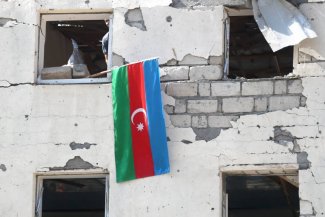Nagorno-Karabakh: Azerbaijan's military successes

The ceasefire between the Armenian and Azerbaijani forces announced on 17 October, after telephone consultations among the foreign ministers of Russia, Armenia and Azerbaijan, has already ended in failure. After one day of lower-intensity firefights, there has been heavy fighting since the morning of 19 October, especially in the southern part of the conflict zone (which is part of the ‘occupied territories’ located between Nagorno-Karabakh itself [the former Nagorno-Karabakh Autonomous Oblast] and Iran). In recent days Azerbaijani forces succeeded in taking over some relatively large Armenian-controlled areas, including the vicinity of the reservoir on the River Araks; this section of the river forms the Azerbaijani-Iranian border (official reports from Baku say about 40 to 60 towns have been captured, although some of them are actually ruins dating from the early 1990s, while others are still being fought over). The parties have been accusing each other of breaking the ceasefire, while declaring their support for it.
Commentary
- The latest events in the combat zone (it should be noted that the reports from the area are incomplete and hard to verify) indicate that Baku is consistently implementing its plan, consisting of taking over as much as possible of the area controlled by the separatist Republic of Nagorno-Karabakh before the fighting began. It should be assumed that Azerbaijan will continue its offensive operations until it encounters effective resistance, or is forced to stop them by an external force (which in practice could only be Russia). The territorial gains achieved so far already represent a great success for Baku, but it can be assumed that it has even greater ambitions; if that were not the case, Azerbaijan could have called an end to the operation on 18 October, taking advantage of the ceasefire and the fact that the country’s Independence Day fell on that day.
- The violations of the successive ceasefires which Russia has negotiated are a blow to the prestige of Moscow, which is unwilling or unable to force the parties to genuinely halt the fighting. It should be assumed that in the event of an existential threat to Armenia itself (or a risk that the Armenian side would lose control over Stepanakert, the unrecognised Nagorno-Karabakh’s capital, before then), Russia will decide to intervene in some form; this would allow it to maintain its influence in the South Caucasus and prevent Turkey from growing in importance in the region. Russia’s obligations to Armenia under the Collective Security Treaty Organisation concern the defence of its internationally recognised territory, and not Nagorno-Karabakh or the other Armenian-occupied territories that belong to Azerbaijan under international law.
- In the present situation, it is most likely that Baku will continue its activities and the Armenians will gradually lose more towns and positions. The Armenian counter-attacks are not bringing the expected results, and the shelling of civilian targets in the Azerbaijani city of Ganja is difficult to justify on military grounds. The speed and effectiveness of Azerbaijan’s offensive actions will be influenced by factors such as the coming winter and the depletion of its resources (although they are much greater than the Armenians’: Azerbaijan has a particular advantage in terms of artillery and drones). Meanwhile, the existence of several defence lines favours the Armenians; Nagorno-Karabakh itself will be the most heavily defended area. The Azerbaijani forces are primarily attacking in a south-westerly direction. If they take more localities in the ‘occupied territories’, they could cover more or less half of the distance (around 50 km as the crow flies) between their starting positions and the interface between the internationally recognised borders of Armenia, Azerbaijan and Iran. Reaching this point would mean not only that they had taken control of the southern road linking Armenia with Nagorno-Karabakh, but it would also open up the option of blocking the Armenian-Iranian border (which is about 35 km in length; the Nakhchivan Autonomous Republic, which belongs to Azerbaijan, lies due west of Armenia on this latitude).
Map. Armenia and Azerbaijan. The area of Nagorno-Karabakh conflict (20 October 2020)

Source: author's own work, based on map from the Censor.net website and press reports.





